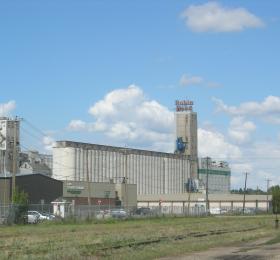Robin Hood Mill
- Regular
Description of the Historic Place
The Robin Hood Mill (also known as Factoria Mill) is a large flour mill located at 95 33rd Street East in Saskatoon’s Central Industrial neighbourhood. Once located on the fringes of the city, the Robin Hood Mill is now surrounded by residential, commercial, and industrial development.
Heritage Value
Flour mills in Saskatchewan were vital industries, especially for the early settlers, and played an important role in the development of agriculture in the Province. As evidenced in the literature of the early 1900s that promoted settlement in Saskatchewan, flour mills were seen as cornerstone industries fit to attract new settlers, additional business, and economic development. Hauling their wheat to the nearest mill, farmers obtained flour which was not only a staple food but also served as barter for other commodities. A portion of their crop was also sold to the mill for cash and exported from the prairie region.
Saskatoon was a logical location for a flour milling industry. There were vast areas of prairie to produce high quality hard spring wheat and the City was capable of becoming a major distribution centre with its railway facilities. The Robin Hood Mill began in 1926 with the purchase of the existing Factoria Mill. Construction began in 1927, and machinery was installed in 1928 to increase capacity. Warehouse storage was added in 1929. Once construction was complete, the Factoria Mill section of the mill, which acted as a branch of the main plant, was demolished in 1938.
The Robin Hood Mill saw a capital investment of about $7 million to modernize its equipment in 1999. At that time, the mill had around 140 employees and produced a large variety of flour mixes for the North American retail market. Today, the Robin Hood Mill symbolizes the importance of flour mills in the development of agriculture in Saskatchewan. The Robin Hood sign on top of the concrete elevator tower serves as a local neighbourhood landmark.
Source: City of Saskatoon Built Heritage Database
Character Defining Elements
Key elements which contribute to the heritage value of this historic resource include:
- Those features that reflect the building’s history and importance in the agricultural industry such as its form, massing, scale, its location, and the ‘Robin Hood’ sign located at the top of the elevator tower.

